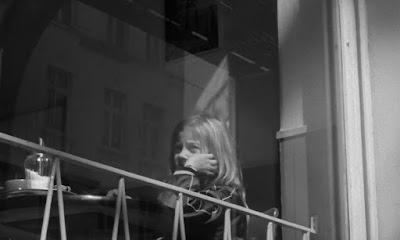In Memoriam
In general, I tend not to make
too many "R.I.P." posts. Other blogs that are more active than mine
make such tributes a regular feature of their postings, but given that I'm not a
very prolific writer here at Lights in
the Dusk, I could imagine such posts becoming overwhelming given the general lack of other
content. The sad fact is that too many great artists come and go and if I were
to acknowledge each of them this blog would turn into an obituary.
However, Robby Müller, the
great Dutch cinematographer famed for his collaborations with Wim Wenders,
among other filmmakers, passed away this week, and it seems necessary to break
from this tradition and share a few words (and images) about his extraordinary
career.
To Live and Die in L.A.
[William Friedkin, 1985]:
Müller was one of my
absolute favourite cinematographers and was someone who seemed to gravitate towards
projects and filmmakers that speak to me on a profoundly personal level.
It's difficult to choose a
favourite film photographed by Müller. Throughout his career he brought a
style, atmosphere and inventiveness that always seemed right for the specific
project. In other words, he served the material. Whether he was working in 16mm
black and white, as in Alice in the Cities (1974), 35mm colour, as in Barfly
(1987), or pioneering the use of digital video, as in Dancer in the Dark
(2000), My Brother Tom (2001) and 24 Hour Party People (2002), respectively, Müller
was able to create lasting images that were bold, iconographic and always attuned
to matters of light, space, character and location.
Whether collaborating with
mainstream Hollywood directors, such as William Friedkin, John Schlesinger and Peter
Bogdanovich, or more idiosyncratic, independent talents, such as Alex Cox, Jim
Jarmusch and Raúl Ruiz, Müller always seemed to bring a level of craftsmanship that
was even more remarkable given the limitations that he chose to embrace.
It's not an overstatement
to suggest that Müller could have had the same career as Roger Deakins, Robert
Richardson, or more recently Hoyte Van Hoytema; working exclusively on big
budget Hollywood pictures for so-called "prestige" filmmakers. Instead,
Müller chose to work with filmmakers that were unconventional, controversial and
often at the start of their careers. In doing so, he nonetheless succeeded in creating
a lifetime's worth of astounding images on small budgets, short schedules and against
incredibly difficult filming conditions.
Robby Müller filming Kings of the Road [photo attributed to Wim Wenders]:
Just focusing on his early
collaborations with Wenders already illustrates Müller's amazing versatility. Moving
from the stylised and Hitchcokian The Goalie's Anxiety at the Penalty Kick
(1972) to the almost documentary like travelogue of Alice in the Cities, we can
appreciate both his mastery of different mediums and his ability to switch
between works of unforced naturalism and painterly stylisation.
The subsequent films that Wenders
and Müller made together would only broaden their creative pallet, as the
emphasis on landscape, or 'place', became a central concern in a film like Kings of the Road (1976) or the early scenes of Paris, Texas (1984), while the
use of colour would become increasingly more daring and expressive, as in the
Edward Hopper influenced Patricia Highsmith adaptation The American Friend
(1977).
The lasting legacy of Müller
is perhaps best surmised by Wenders himself, who in a tribute to his former
collaborator, states: "Like no other,
you were able to seize moods and to describe situations in your imagery that
revealed more about the characters than long dialogues or dramaturgical
structures ever could. You knew how to create a distinctive atmosphere for each
and every film, in which the respective actors were, in the truest sense of the
phrase, "in good hands." For a handful of filmmakers, among whom I
was one, you were their most important companion, like Hans W., Jim, Lars,
Steve. And you were a role model for a whole generation of young directors of
photography."
Below are some images
taken from my absolute favourite films photographed by Robby Müller, which I
hope illustrate many of the qualities discussed here, as well as providing a
chronological record of his stylistic progression, trademarks, characteristics
and key works.
Alice in the Cities [Wim
Wenders, 1974]:
Kings of the Road [Wim
Wenders, 1976]:
The Left-Handed Woman [Peter
Handke, 1978]:
The American Friend [Wim
Wenders, 1977]:
They All Laughed [Peter
Bogdanovich, 1981]:
Repo Man [Alex Cox, 1984]:
Paris, Texas [Wim Wenders,
1984]:
To Live and Die in L.A. [William
Friedkin, 1985]:
Down by Law [Jim Jarmusch,
1986]:
Mystery Train [Jim
Jarmusch, 1989]:
Korczak [Andrzej Wajda,
1990]:
Until the End of the World
[Wim Wenders, 1991]:
Dead Man [Jim Jarmusch,
1995]:
Breaking the Waves [Lars
von Trier, 1996]:
The Tango Lesson [Sally
Potter, 1997]:
Dancer in the Dark [Lars
von Trier, 2000]:
Ashes [Steve McQueen,
2014]:






















